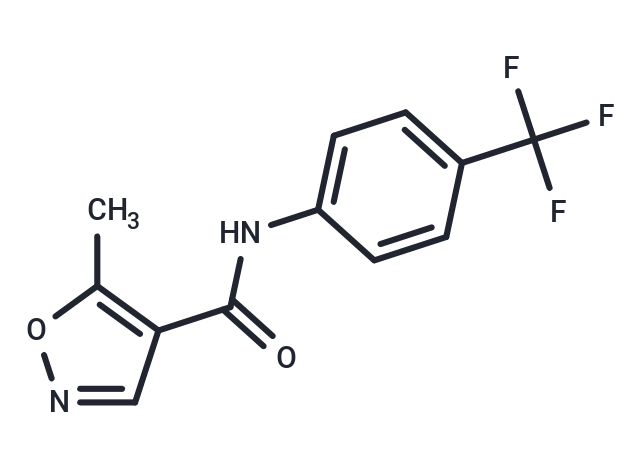Shopping Cart
- Remove All
 Your shopping cart is currently empty
Your shopping cart is currently empty

Leflunomide (HWA486) is an immunomodulatory agent used in the therapy of rheumatoid arthritis and psoriatic arthritis.

| Pack Size | Price | Availability | Quantity |
|---|---|---|---|
| 50 mg | $39 | In Stock | |
| 100 mg | $52 | In Stock | |
| 200 mg | $72 | In Stock | |
| 500 mg | $162 | In Stock | |
| 1 mL x 10 mM (in DMSO) | $58 | In Stock |
| Description | Leflunomide (HWA486) is an immunomodulatory agent used in the therapy of rheumatoid arthritis and psoriatic arthritis. |
| In vitro | Leflunomide is an immunomodulatory drug that acts by inhibiting the mitochondrial enzyme dihydrolactate dehydrogenase.Leflunomide inhibits anti-CD3- and interleukin-2 (IL-2)-stimulated T-cell proliferation.Leflunomide also inhibits the response stimulated by the anti-CD3 monoclonal antibody to the production of IL-2 and the expression of the IL-2 receptor in human T lymphocytes. Leflunomide also inhibits IL-2-stimulated tyrosine phosphorylation in CTLL-4 cells.Leflunomide prevents activation and expansion of autoimmune lymphocytes by interfering with cell cycle progression due to insufficient production of rUMP and the use of mechanisms involved in p53.Leflunomide inhibits p53-stimulated T-cell proliferation in an in vitro tyrosine kinase assay. assay, was able to inhibit p59fyn and p56lck activity. |
| In vivo | Leflunomide is an immunomodulatory drug that acts by inhibiting the mitochondrial enzyme dihydrolactate dehydrogenase.Leflunomide inhibits anti-CD3- and interleukin-2 (IL-2)-stimulated T-cell proliferation.Leflunomide also inhibits the response stimulated by the anti-CD3 monoclonal antibody to the production of IL-2 and the expression of the IL-2 receptor in human T lymphocytes. Leflunomide also inhibits IL-2-stimulated tyrosine phosphorylation in CTLL-4 cells.Leflunomide prevents activation and expansion of autoimmune lymphocytes by interfering with cell cycle progression due to insufficient production of rUMP and the use of mechanisms involved in p53.Leflunomide inhibits p53-stimulated T-cell proliferation in an in vitro tyrosine kinase assay. assay, was able to inhibit p59fyn and p56lck activity. |
| Kinase Assay | DHODase activity is measured by the DCIP colorimetric assay. This is a coupled assay in which oxidation of DHO and subsequent reduction of ubiquinone are stoichiometrically equivalent to the reduction of DCIP. Reduction of DCIP is accompanied by a loss of absorbance at 610 nm (ε=21500 M/cm). The assay is performed in a 96-well microtiter plate at ambient temperature (ca. 25°C). Stock solutions of 10 mM leflunomide and A771726 are prepared in dimethyl sulfoxide (DMSO) and these are diluted with reaction buffer (100 mM Tris and 0.1 % Triton X-100, pH 8.0) to prepare working stocks of the inhibitors at varying concentrations. For each reaction, the well contained 10 nM DHODase, 68 μM DCIP, 0.16 mg/mL gelatin, the stated concentration of ubiquinone, 10 μL of an inhibitor working stock to give the stated final concentration, and reaction buffer. After a 5-min equilibration period, the reaction is initiated by addition of DHO to the stated final concentrations. The total volume of reaction mixture for each assay is 150 μL, and the final DMSO concentration is ≤ 0.01% (v/v). The reaction progress is followed by recording the loss of absorbance at 610 nm over a 10-min period (during which the velocity remained linear). Velocities are reported as the change in absorbance at 610 nm per minute, and each reported value is the average of three replicates. In experiments where the DHO or ubiquinone concentration is varied, the other substrate is held constant at 200 μM. To determine the inhibitor potency of leflunomide and A771726, the effects of varying concentrations of the two compounds on the initial velocity of the DHODase reaction is measured over a concentration range of 0.01?1.0 μM. In these experiments the DHO and ubiquinone concentrations are held constant at 200 and 100 μM, respectively. |
| Alias | SU101, RS-34821, HWA486 |
| Molecular Weight | 270.21 |
| Formula | C12H9F3N2O2 |
| Cas No. | 75706-12-6 |
| Smiles | CC1=C(C=NO1)C(=O)NC1=CC=C(C=C1)C(F)(F)F |
| Relative Density. | 1.392 g/cm3 (Predicted) |
| Storage | keep away from moisture | Powder: -20°C for 3 years | In solvent: -80°C for 1 year | Shipping with blue ice. | ||||||||||||||||||||||||||||||
| Solubility Information | DMSO: 16.67 mg/mL (61.69 mM), Sonication is recommended. Ethanol: 27 mg/mL (99.92 mM), Sonication is recommended. | ||||||||||||||||||||||||||||||
Solution Preparation Table | |||||||||||||||||||||||||||||||
DMSO/Ethanol
| |||||||||||||||||||||||||||||||

Copyright © 2015-2025 TargetMol Chemicals Inc. All Rights Reserved.